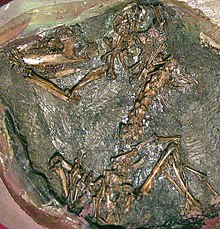| Cladotheres Temporal range:
| |
|---|---|

| |
| Fossil of the basal cladotherian Henkelotherium guimarotae | |
| Scientific classification | |
| Domain: | Eukaryota |
| Kingdom: | Animalia |
| Phylum: | Chordata |
| Class: | Mammalia |
| Clade: | Trechnotheria |
| Clade: | Cladotheria McKenna, 1975 |
| Subgroups | |
| |
Cladotheria is a clade (sometimes ranked as a legion)[2] of mammals. It contains modern therian mammals (marsupials and placentals) and several extinct groups, such as the "dryolestoids", amphitheriids and peramurids. The clade was named in 1975 by Malcolm McKenna. In 2002, it was defined as a node-based taxon containing "the common ancestor of dryolestids and living therians, plus all its descendants".[1] A different, stem-based definition was given in 2013, in which Cladotheria contains all taxa that are closer to Mus musculus (the house mouse) than to the "symmetrodont" Spalacotherium tricuspidens.[3]
Cladotheria incorporates a set of nested mammal clades culminating in Tribosphenida (also known as Boreosphenida), mammals with fully tribosphenic teeth such as therians and a few of their closest relatives. The clade Prototribosphenida includes "the common ancestor of Vincelestes and living therians, plus all of its descendants". Apart from tribosphenids, Prototribosphenida also includes amphitheriids and peramurids, as well as a few isolated genera such as Vincelestes. It excludes the various basal cladotherian groups which have been combined under the label "dryolestoids".[1] The clade Zatheria is even more exclusive, restricted to solely peramurids and tribosphenids. Zatheria is defined as "the common ancestor of Peramus and living marsupials and placentals, plus all of its descendants".[1]